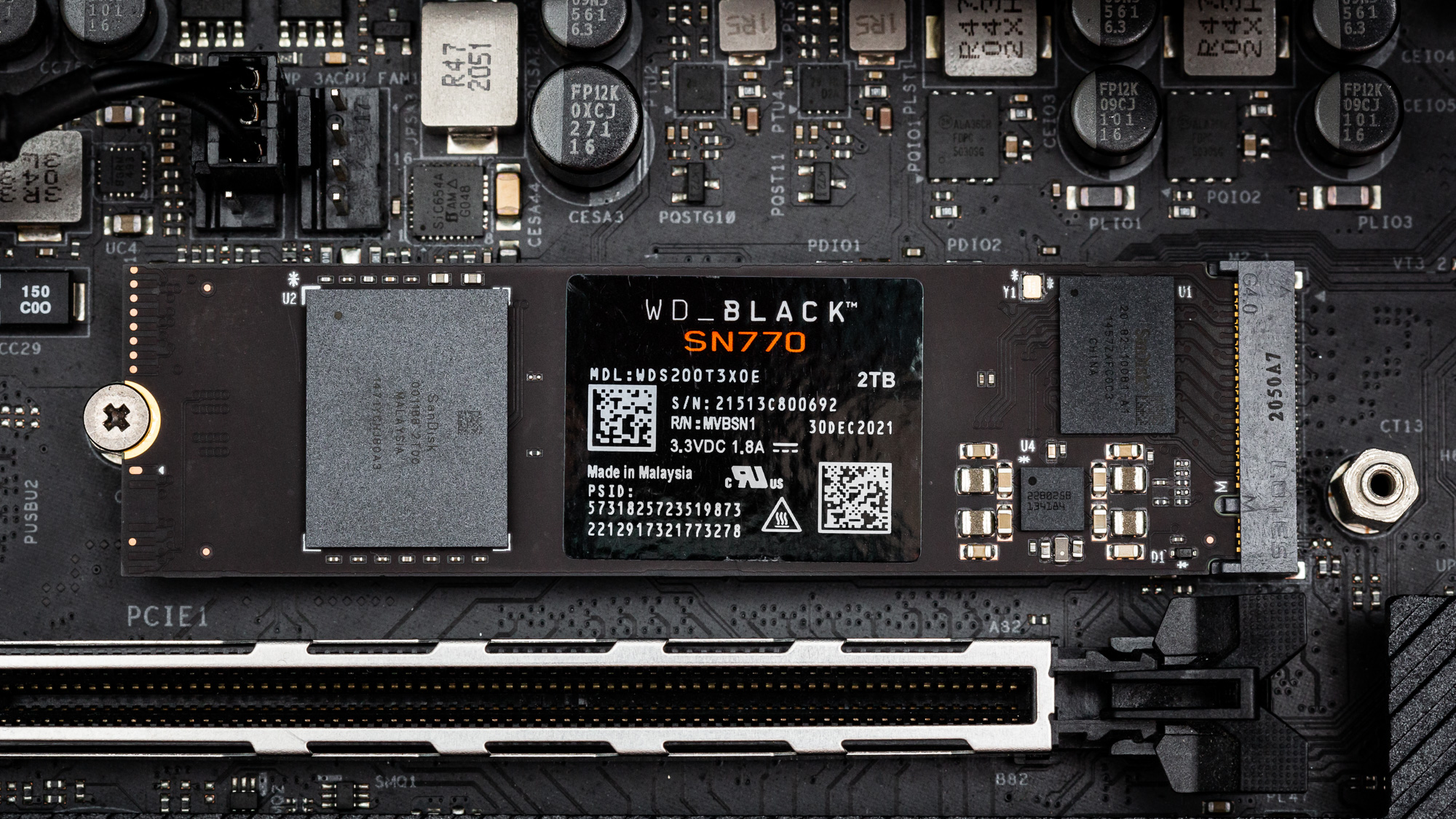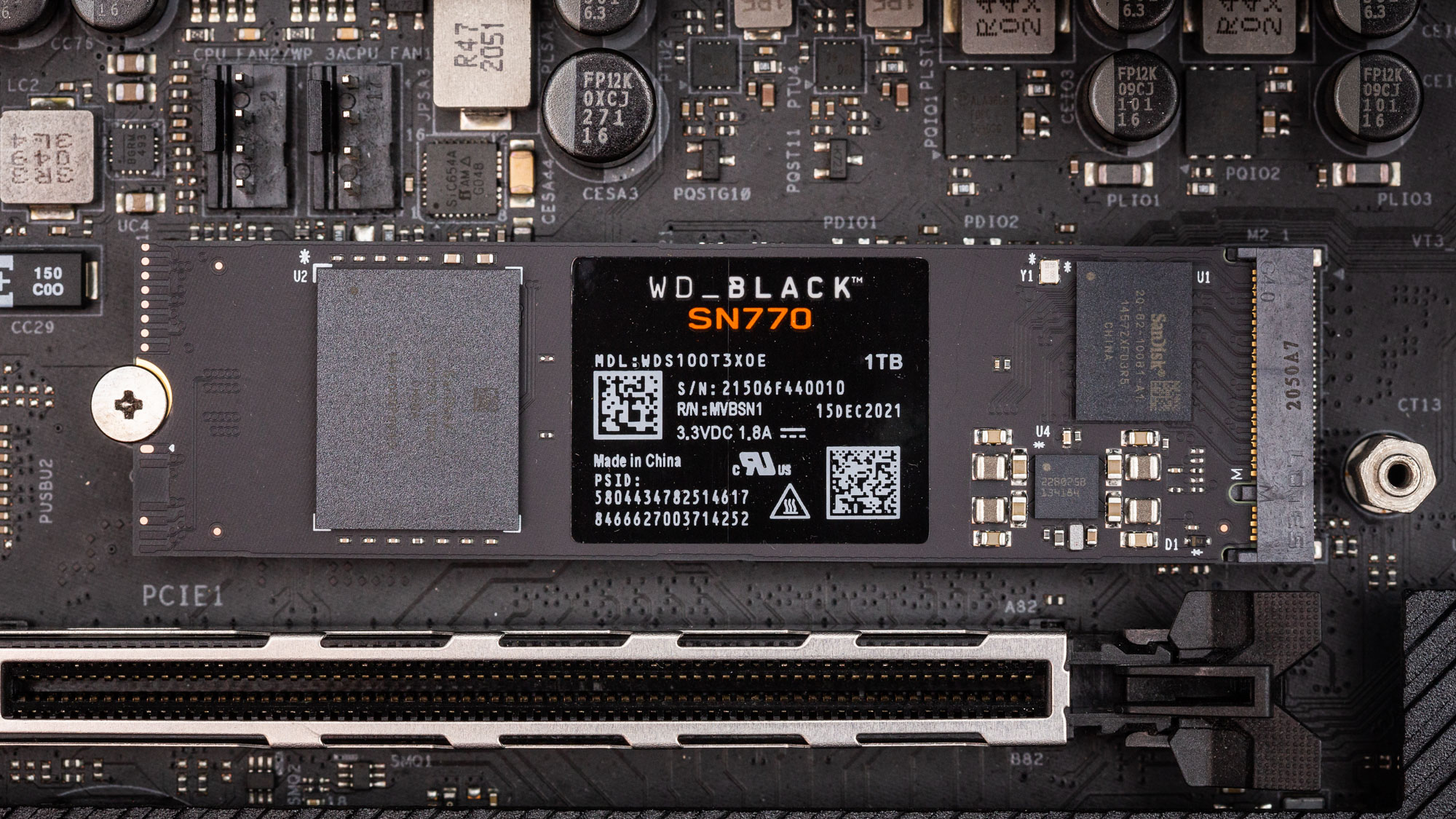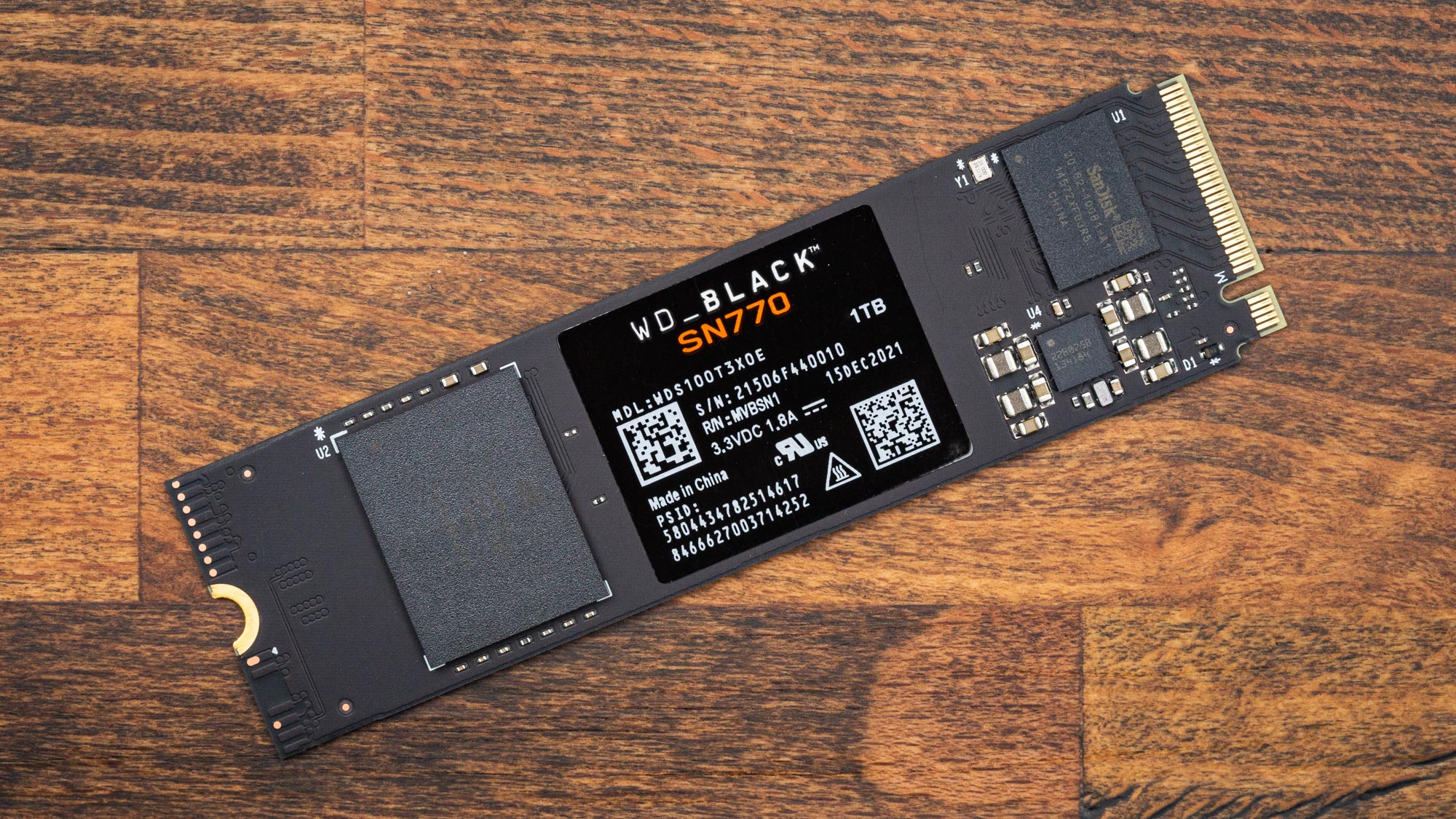Why you can trust Tom's Hardware
1TB WD Black SN770
RATING: ★★★★ 1/2 (4.5 Stars)
PROS
+ Fast performance and cool operation
+ Competitive pricing
+ Aesthetics
+ 5-year warranty
CONS
- Slow write speed after write cache fills
- Lacks AES hardware encryption
- Not available in 4TB
OUR VERDICT
Although it may not quite saturate the PCIe 4.0 connection, WD’s Black SN770 1TB is an extremely responsive and efficient SSD that trades blows with the best of the best, but for a fraction of the price.
Get Tom's Hardware's best news and in-depth reviews, straight to your inbox.
Comparison Products
Today, we put the SN770 against some of the best SSDs available. We include the WD Black SN850, Black SN750 SE, Black SN770, and Blue SN570. All of the WD Black SSDs have Game Mode enabled for comparison, but we show both the enabled and disabled results for the SN770. We also threw in the Kingston KC3000, Crucial P5 Plus, and Samsung 980 Pro with Full Power Mode enabled.
Trace Testing - 3DMark SSD Performance Test for Gamers
Built for gamers, 3DMark’s Storage Benchmark focuses on real-world gaming performance. Each round in this benchmark stresses storage based on gaming activities including loading games, saving progress, installing game files, and recording gameplay video streams.
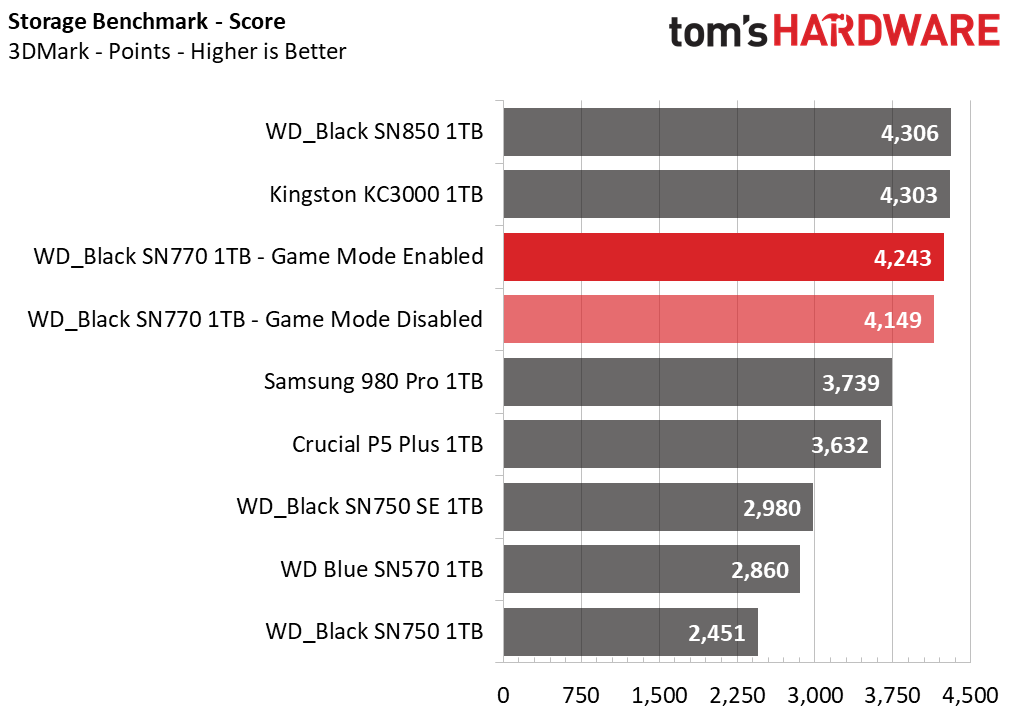
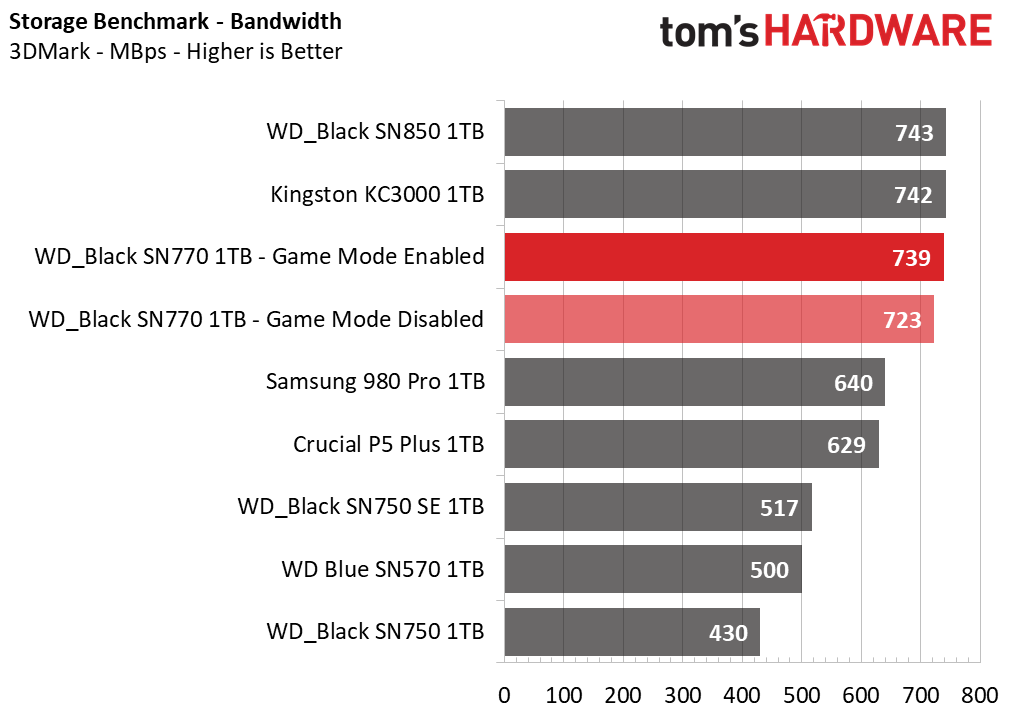
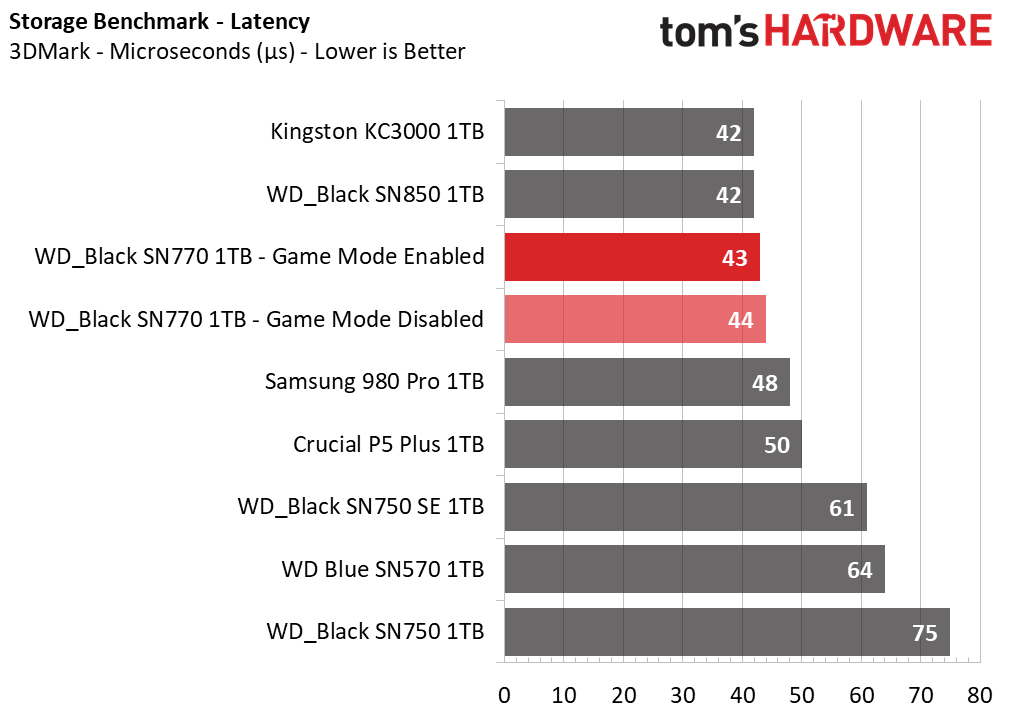
The Kingston KC3000 and WD Black SN850 both delivered nearly unparalleled performance in this benchmark, at least until we ran the SN770 through its paces. Although the SN770 has restricted sequential bandwidth, it’s almost as responsive as these two top-ranking SSDs in this gamer-focused benchmark.
The SN770 also managed to beat the 980 Pro and P5 Plus (Samsung and Crucial’s best), but it beat them with both Game Mode enabled and disabled, too. The Black SN770 was roughly 2.2% faster with Game Mode enabled.
Trace Testing – PCMark 10 Storage Benchmark
PCMark 10 is a trace-based benchmark that uses a wide-ranging set of real-world traces from popular applications and everyday tasks to measure the performance of storage devices.
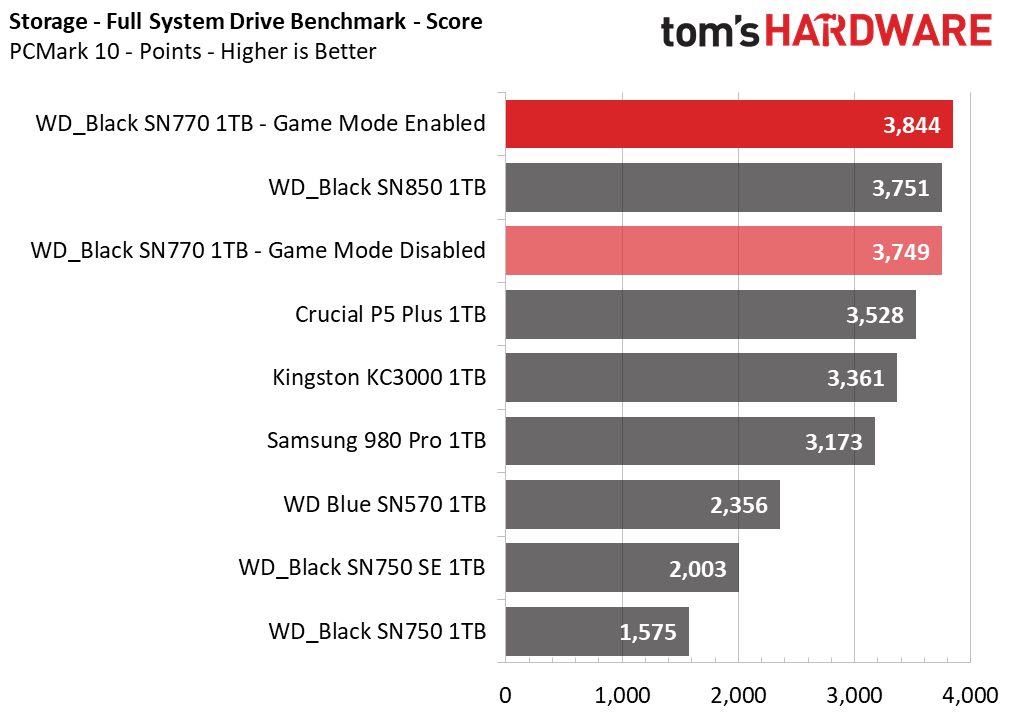
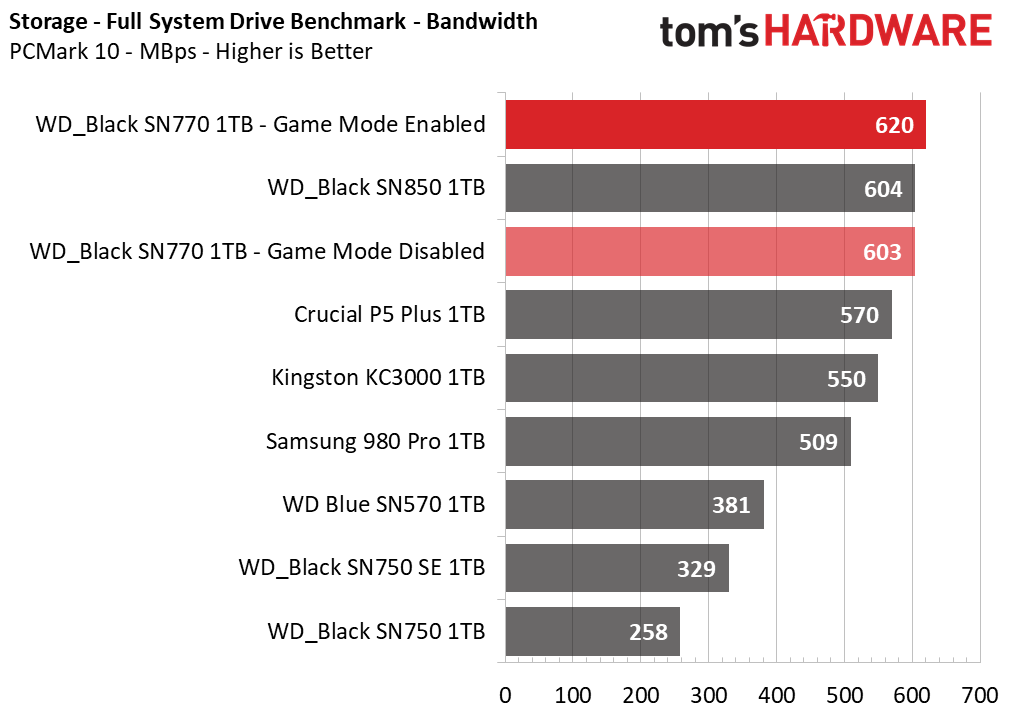
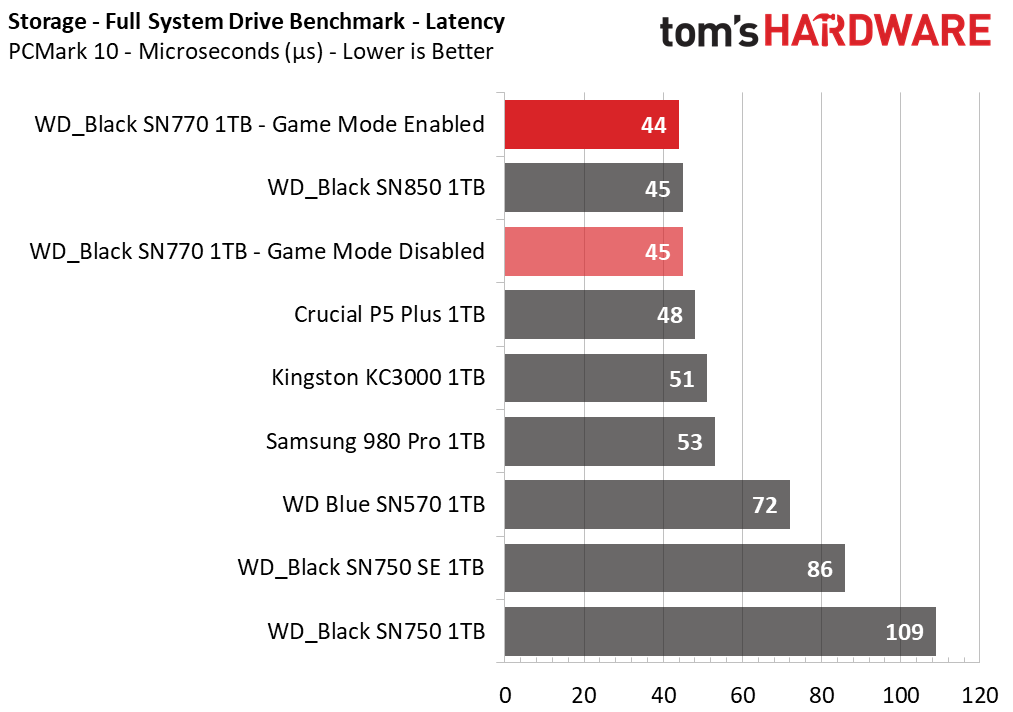
The WD Black SN770 proved extremely well optimized for consumer applications as it delivered the fastest results in PCMark 10. Although the SN850 was WD’s best SSD last year, the new SN770 delivered a devastating blow in this heavy workload when we enabled Game Mode. Even with Game Mode disabled, the SN770 outperformed the rest of the high-performance competitors, reigning supreme.
Transfer Rates – DiskBench
We use the DiskBench storage benchmarking tool to test file transfer performance with a custom, 50GB dataset. We copy 31,227 files of various types, such as pictures, PDFs, and videos to a new folder and then follow-up with a reading test of a newly-written 6.5GB zip file.
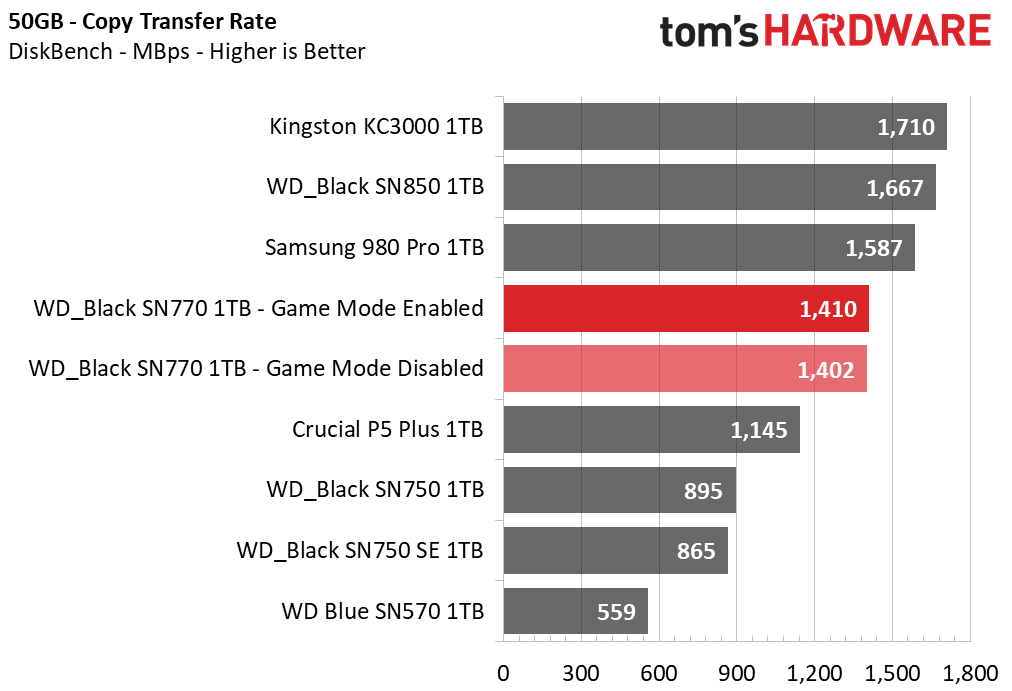
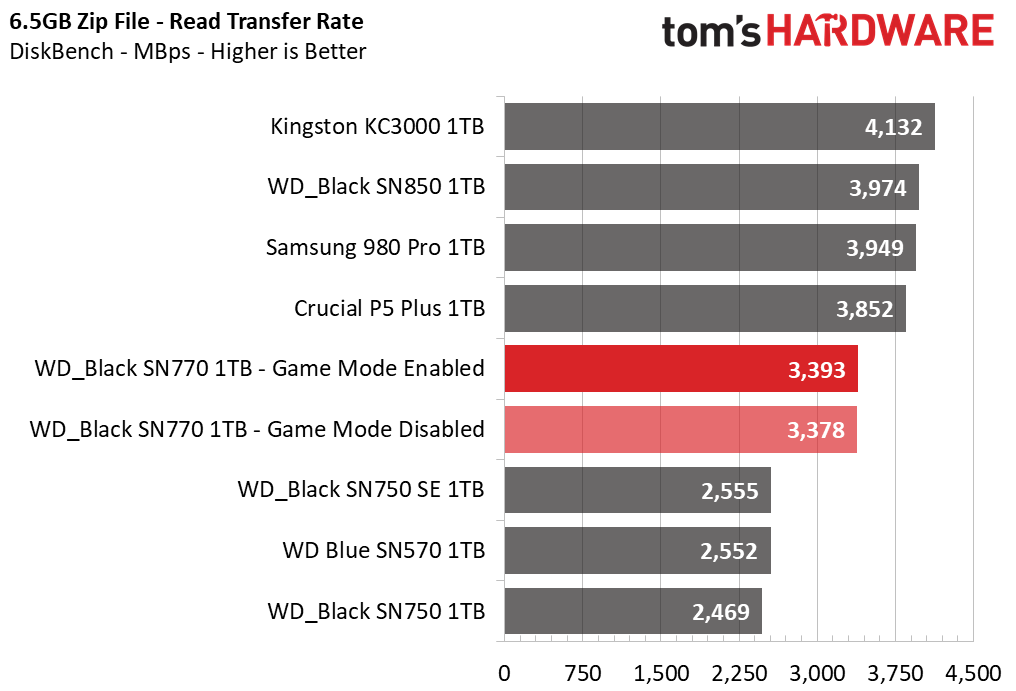
When it comes to handling real files in real-world copy and reading scenarios, the Kingston KC3000, WD Black SN8500, and Samsung 980 Pro all demonstrated why they command a premium over the SN770. Each delivered roughly 200-300 MBps faster copy speeds and 500-700 MBps faster read speeds.
The SN770 may not have been the fastest in the test pool with its fourth-place showing, but it did demonstrate solid performance gains over its predecessors.
Synthetic Testing - ATTO / CrystalDiskMark
ATTO and CrystalDiskMark (CDM) are free and easy-to-use storage benchmarking tools that SSD vendors commonly use to assign performance specifications to their products. Both of these tools give us insight into how each device handles different file sizes.

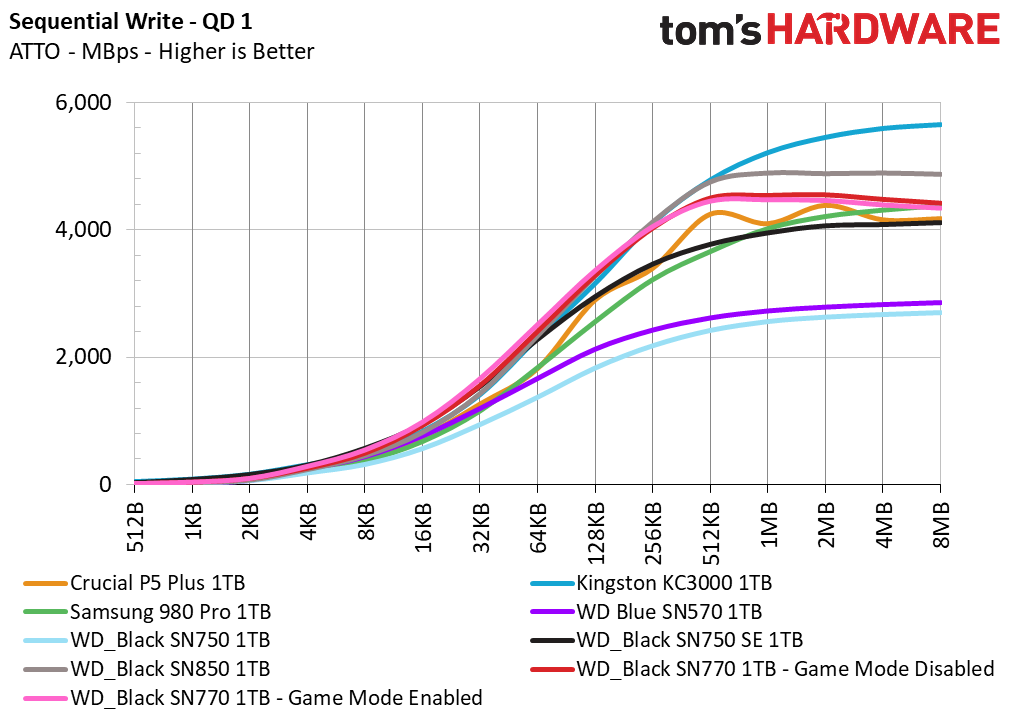
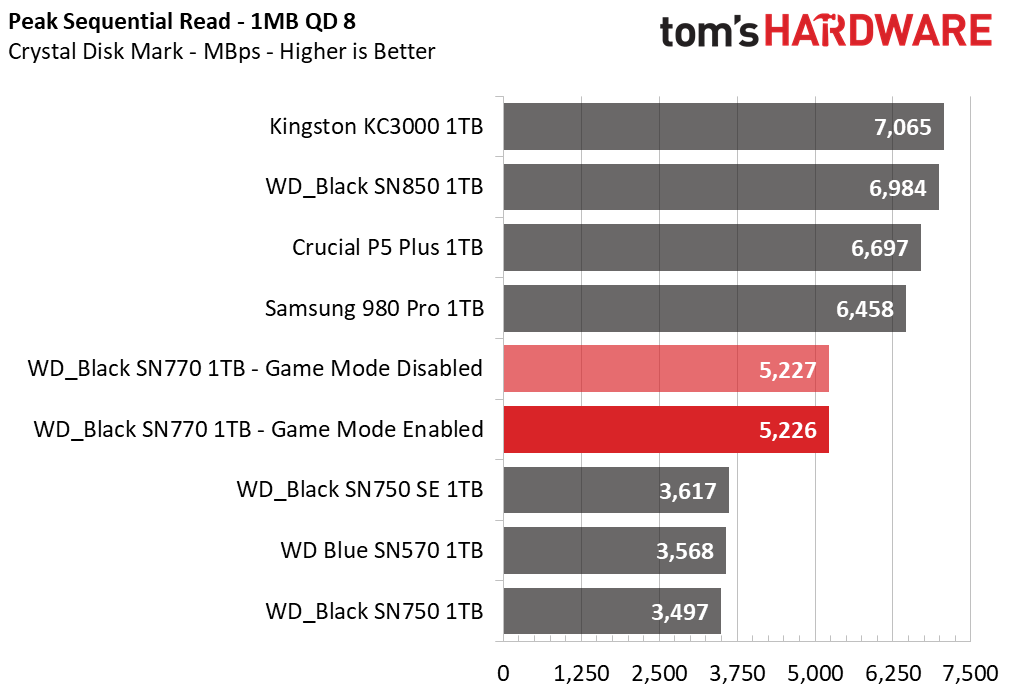
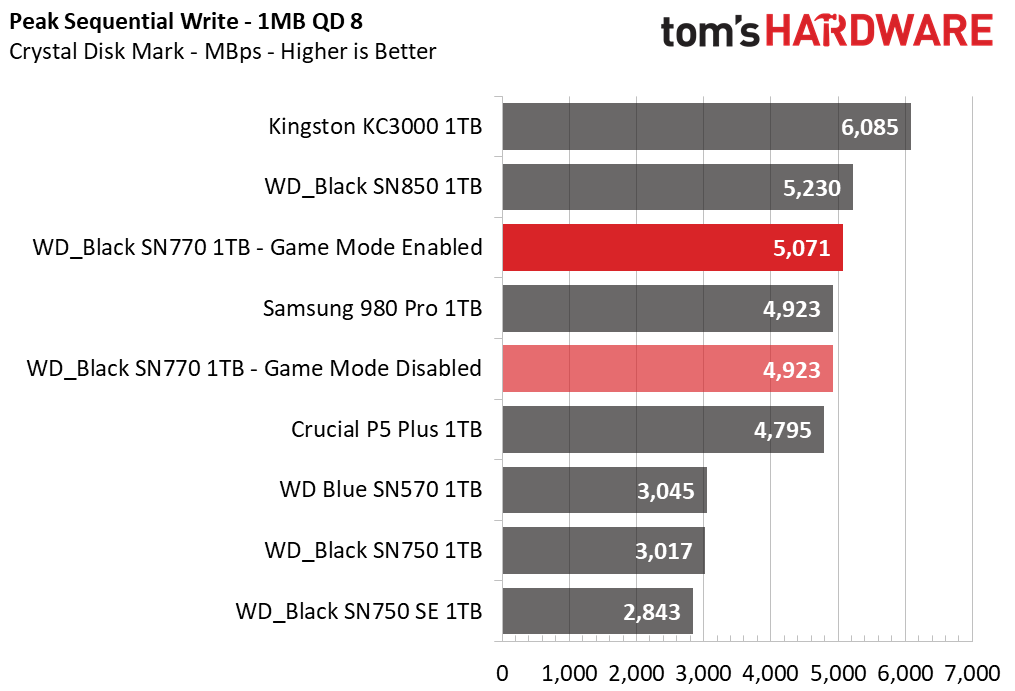
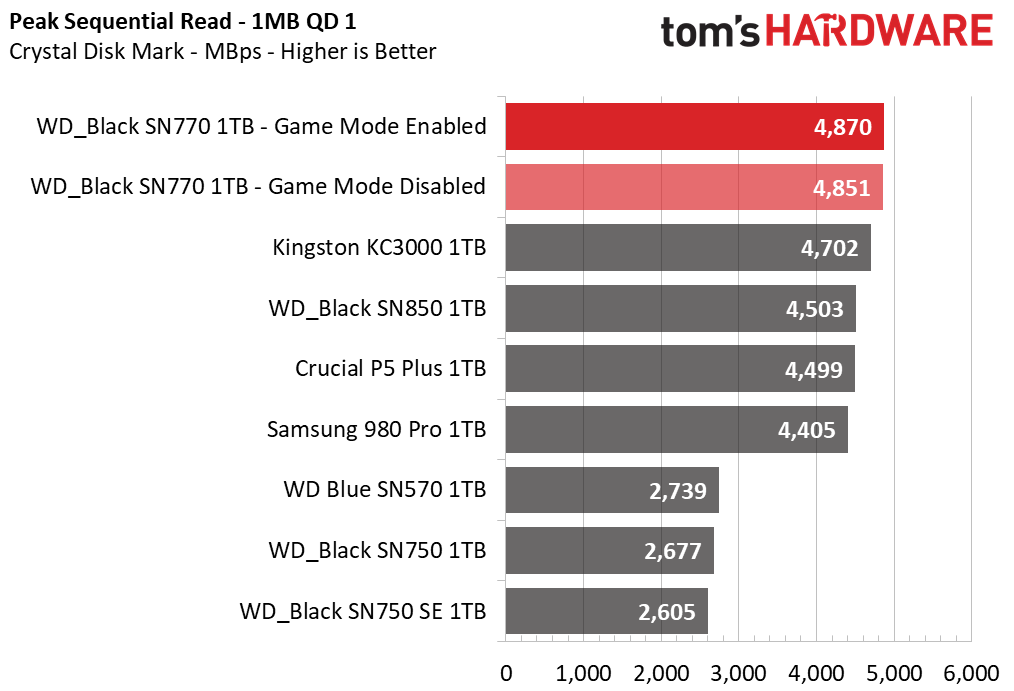



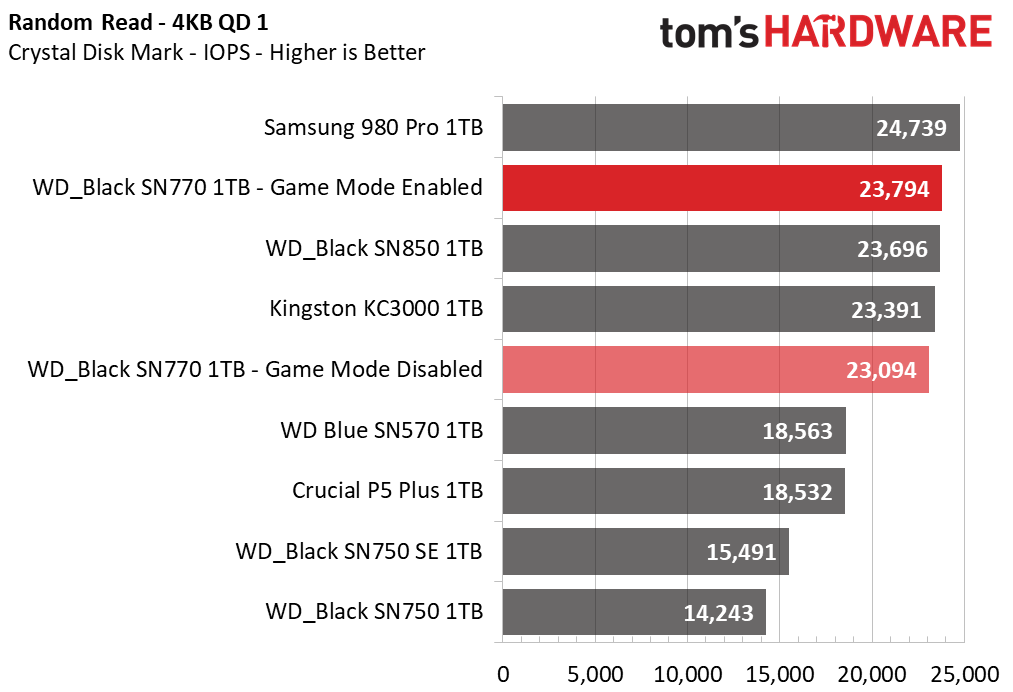
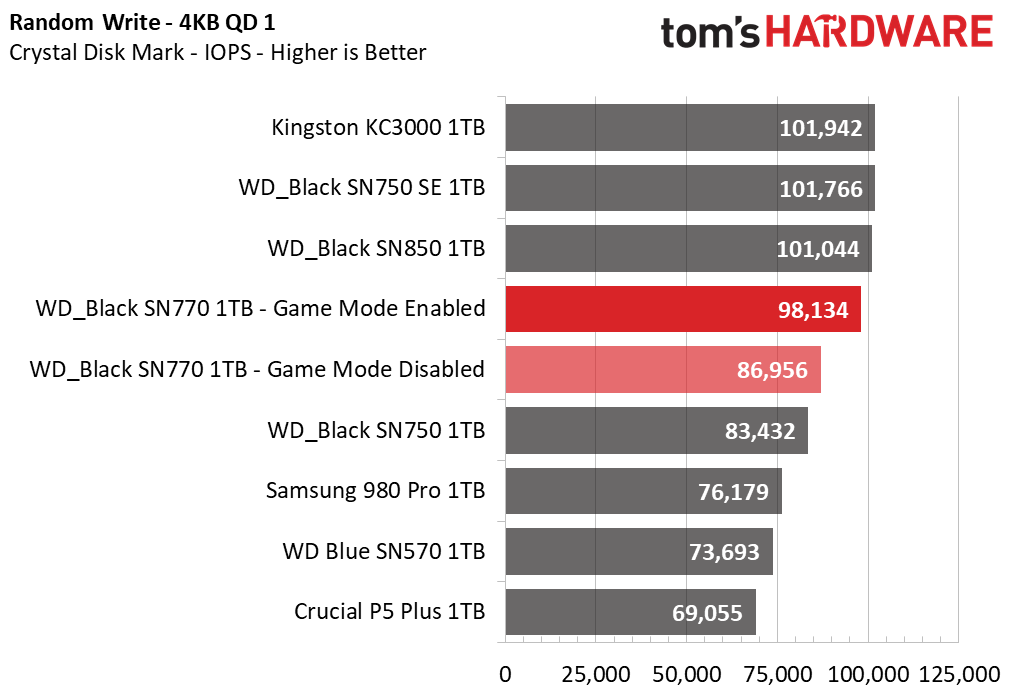
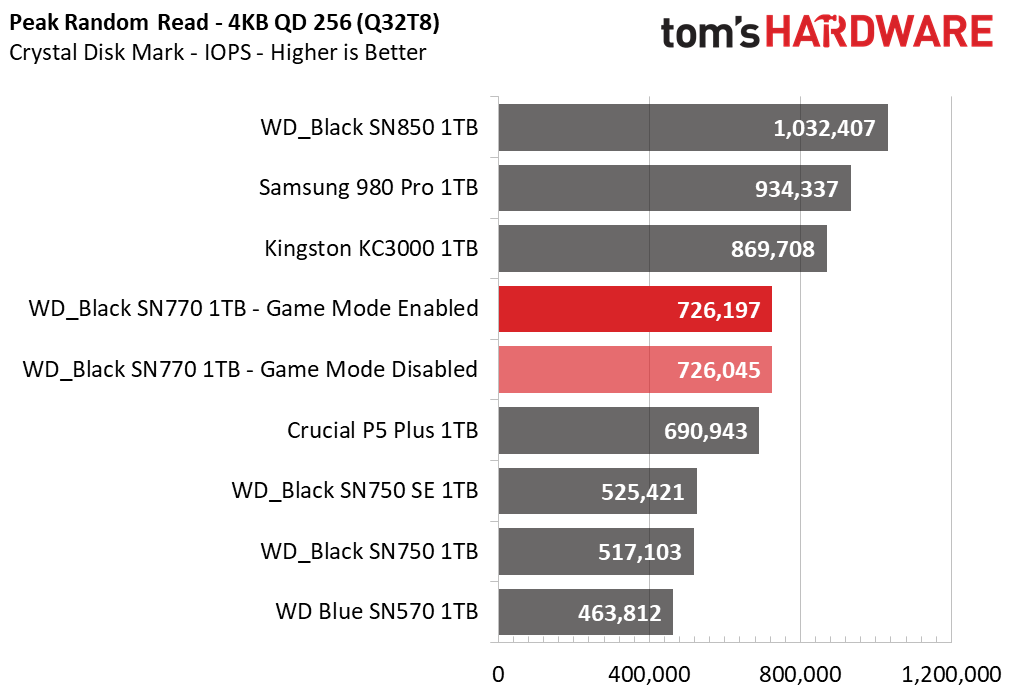
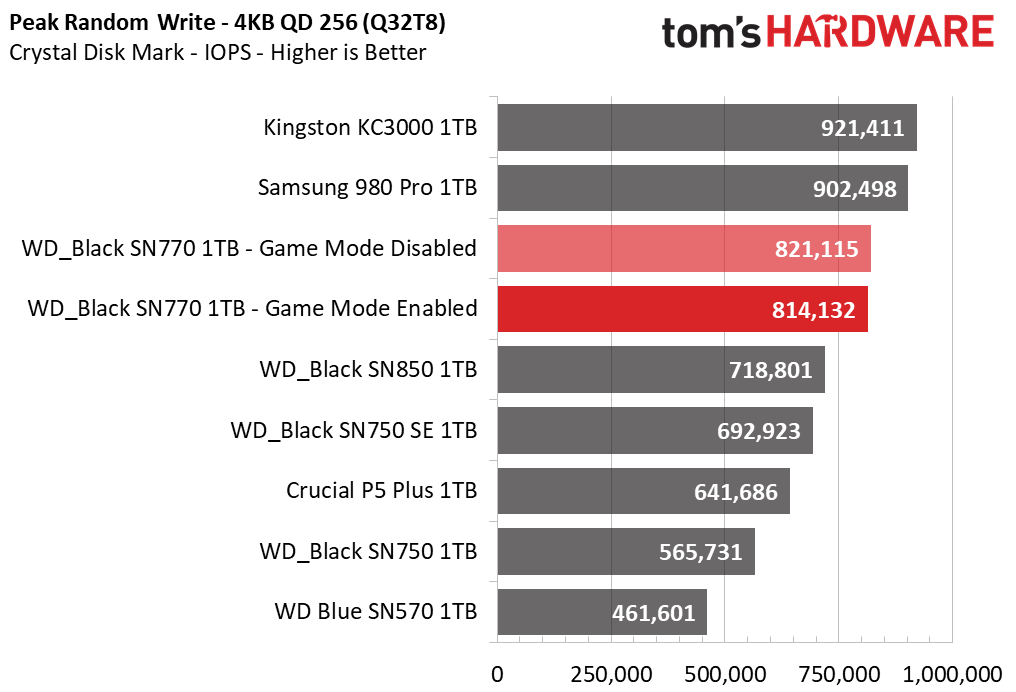
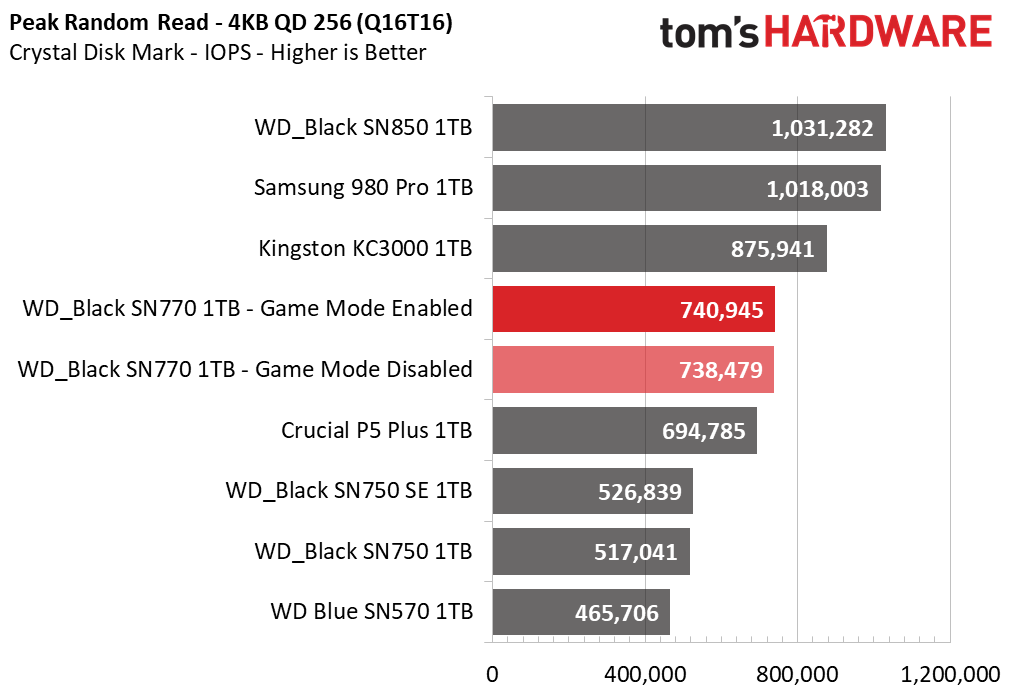
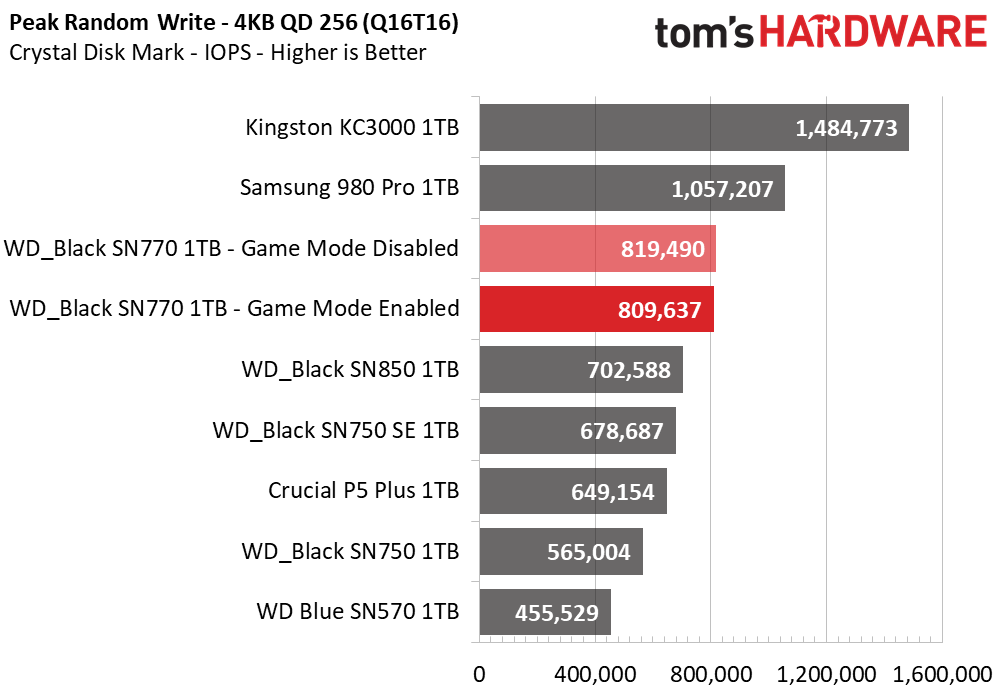
The WD Black SN770 delivered solid sequential performance across most block sizes, but slowed around the 1MB mark in ATTO.
On the other hand, in Crystal Disk Mark, the SN770 delivered the fastest 1MB Queue Depth (QD) 1 read result and the third-fastest write result. Random performance was very impressive, too. While the SN770 delivered a solid result with Game Mode disabled, enabling Game Mode propelled the SN770’s 4KB QD1 random read performance ahead of both the Kingston KC3000 and WD Black SN850, ranking second to the Samsung 980 Pro.
Sustained Write Performance and Cache Recovery
Official write specifications are only part of the performance picture. Most SSDs implement a write cache, which is a fast area of (usually) pseudo-SLC programmed flash that absorbs incoming data. Sustained write speeds can suffer tremendously once the workload spills outside of the cache and into the "native" TLC or QLC flash. We use Iometer to hammer the SSD with sequential writes for 15 minutes to measure both the size of the write cache and performance after the cache is saturated. We also monitor cache recovery via multiple idle rounds.

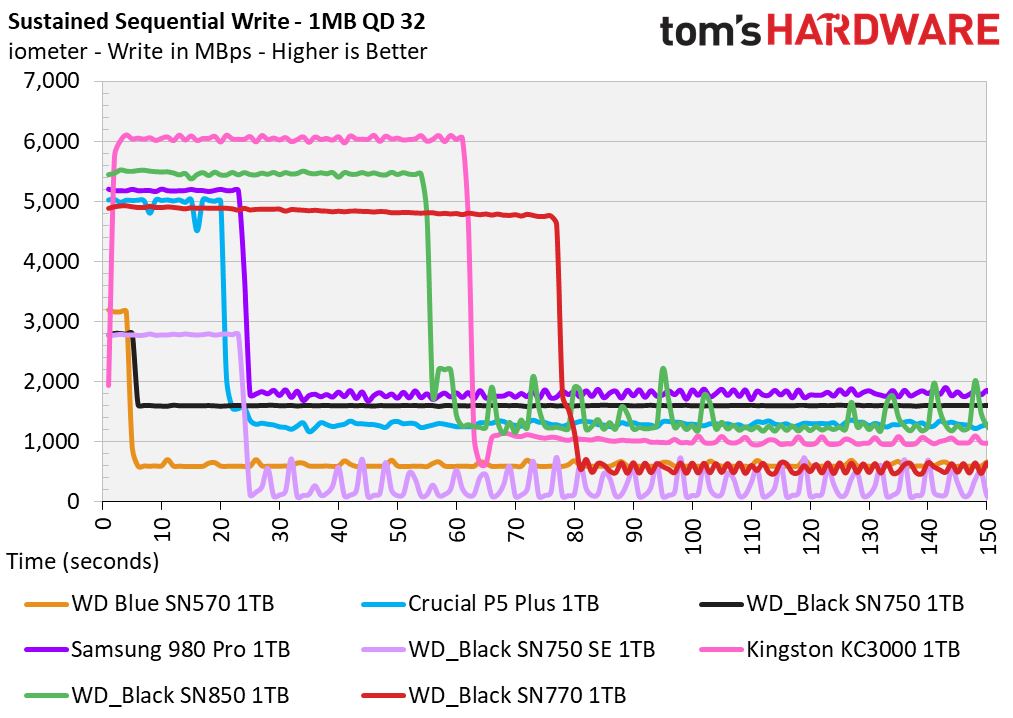
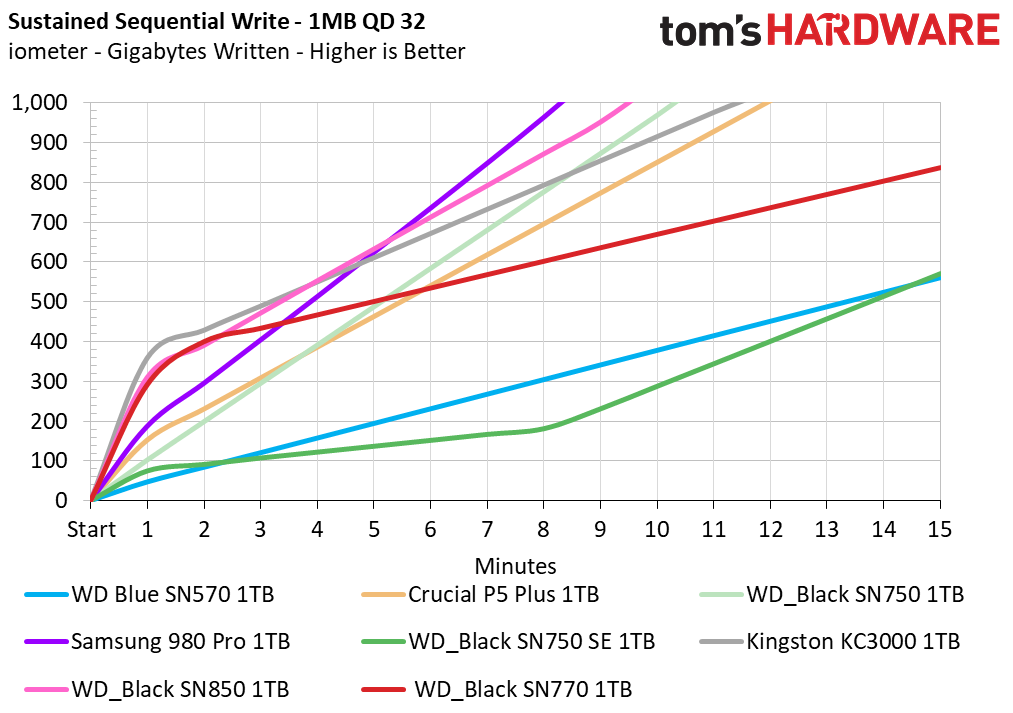
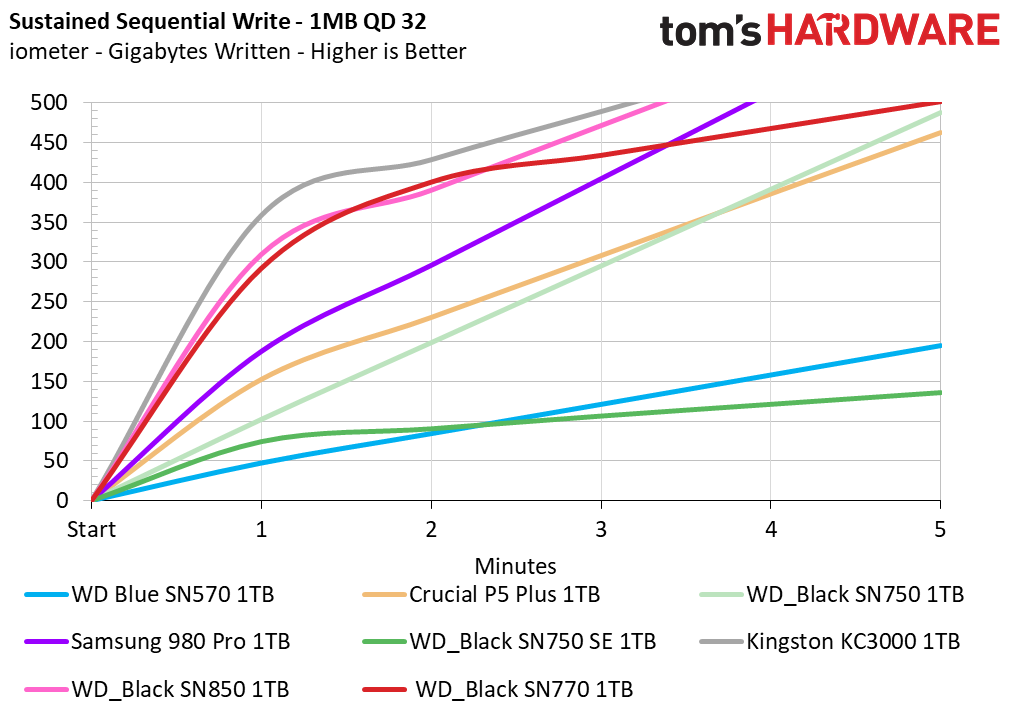
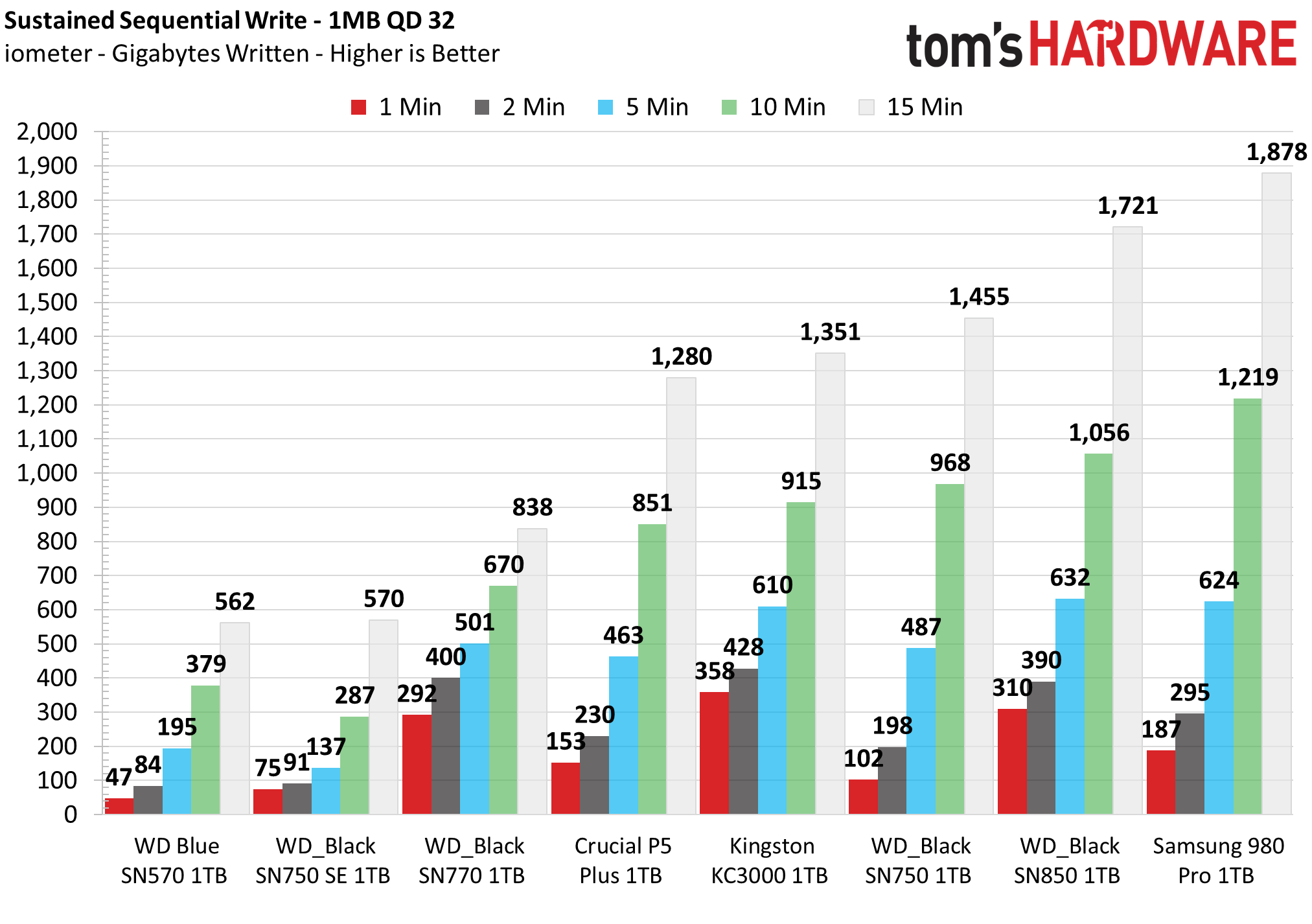
Unlike the SN750 SE, the SN770 doesn't exhibit strange write behavior when we tested with iometer — the cache size and degraded-state write behavior was the same as when dragging and dropping files onto the SSD. The SN770's sustained write performance wasn't quite as good as the original SN750's due to its four NAND channels, lack of DRAM, and fully dynamic SLC cache. However, it is better suited to consumer workloads and recovers quickly.
Our 1TB sample absorbed roughly 377GB of data at a rate of 4,850 MBps before it degraded. After the SLC cache saturated, the SN770 wrote at roughly 560 MBps for the remainder of the test. When given time to idle and recover, the SN770 did so quickly. It evacuated its SLC cache at a rate of roughly 30GB per every minute of idle. We also noticed that in each idle round write pass; the write speed would not degrade to such lows as 560 MBps but rather to a higher average of 1.5 GBps.
Power Consumption and Temperature
We use the Quarch HD Programmable Power Module to gain a deeper understanding of power characteristics. Idle power consumption is an important aspect to consider, especially if you're looking for a laptop upgrade as even the best Ultrabooks can have mediocre storage.
Some SSDs can consume watts of power at idle while better-suited ones sip just milliwatts. Average workload power consumption and max consumption are two other aspects of power consumption, but performance-per-watt is more important. A drive might consume more power during any given workload, but accomplishing a task faster allows the drive to drop into an idle state more quickly, ultimately saving energy.
We also monitor the drive’s temperature via the S.M.A.R.T. data and an IR thermometer to see when (or if) thermal throttling kicks in and how it impacts performance. Remember that results will vary based on the workload and ambient air temperature.
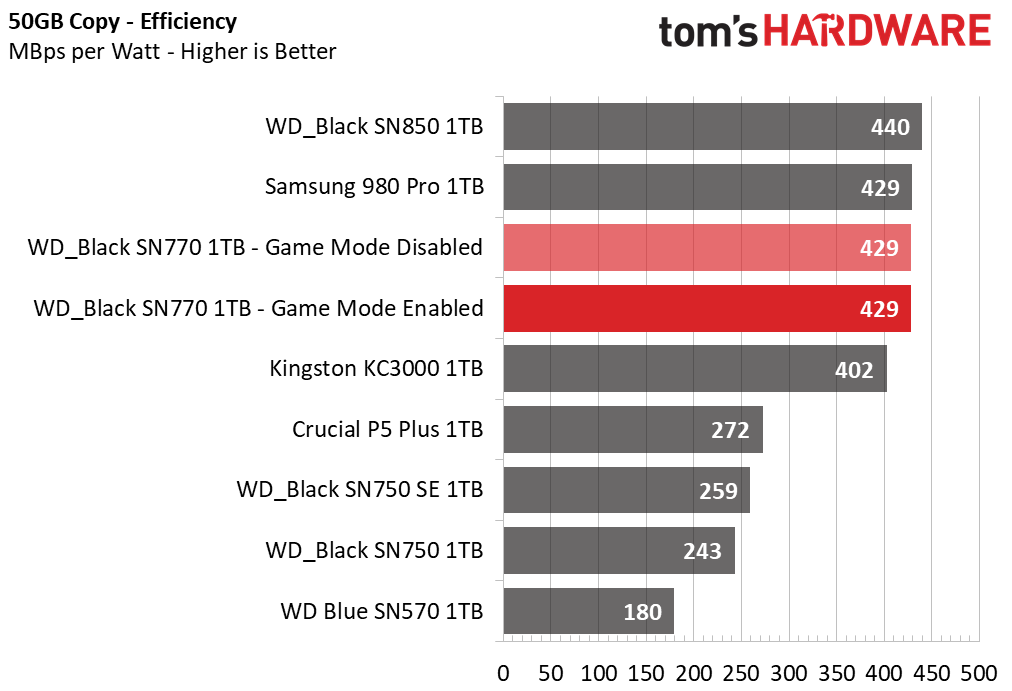
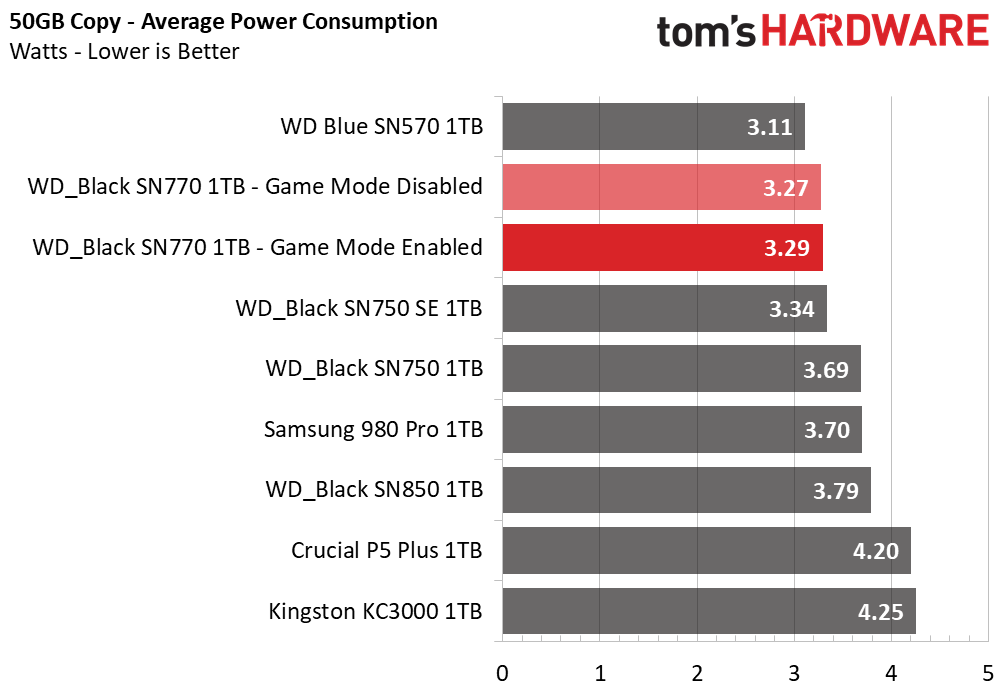
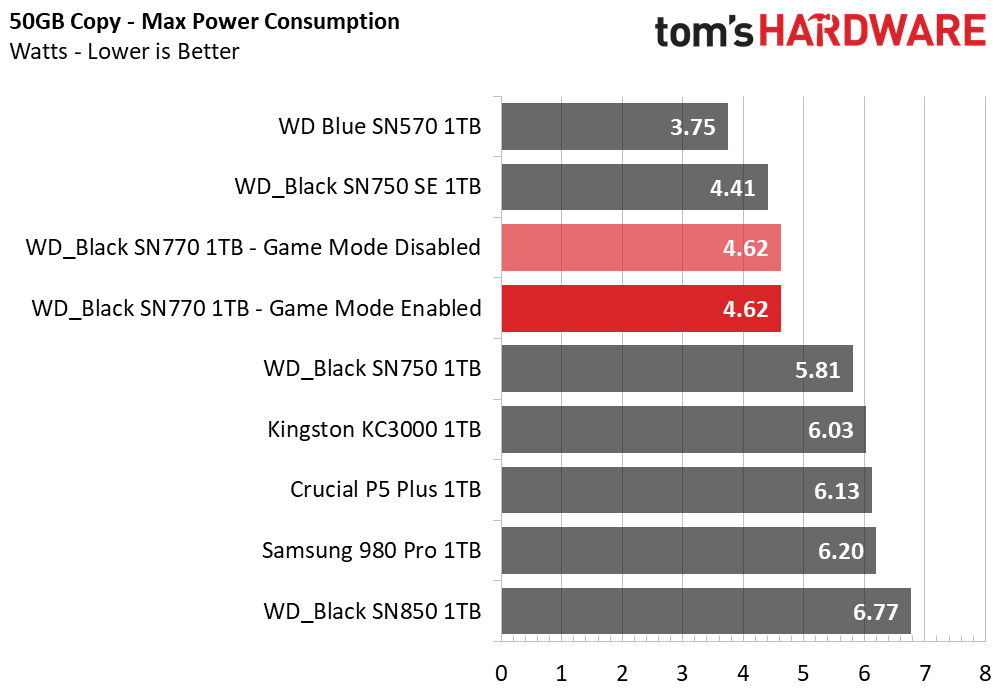
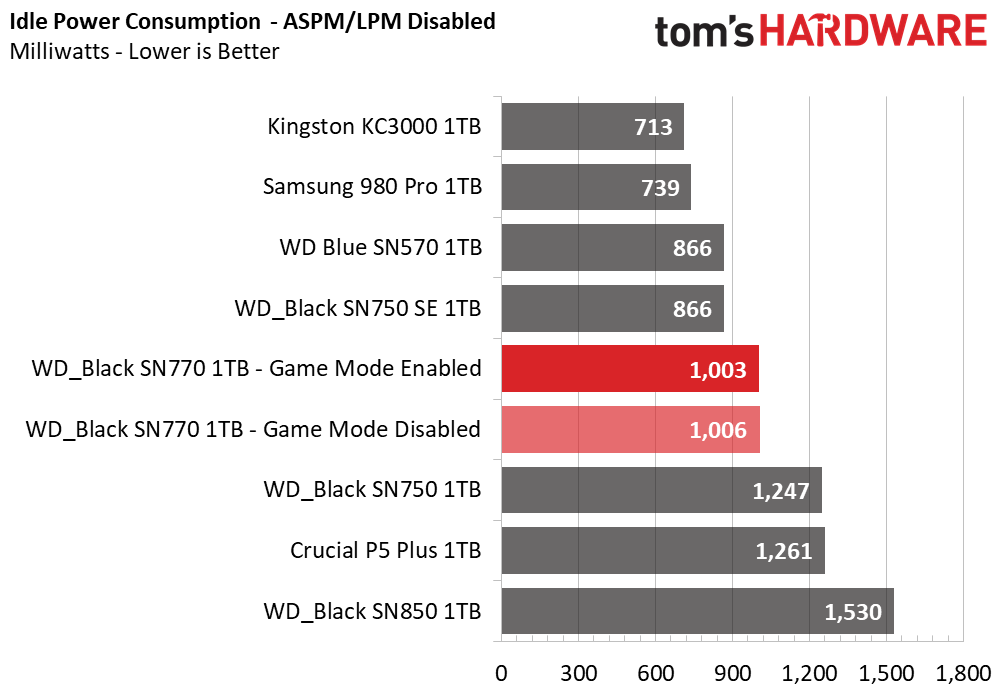
In terms of its efficiency under load, the WD Black SN770 tied the Samsung 980 Pro and just barely trailed the WD Black SN850. Aside from the SN570, the SN770 consumed the least power while beating Crucial P5 Plus. Not only did it outperform the P5 Plus, but it also delivered the second-best WD Black efficiency score out of the tested models. Idle power consumption is a bit high, but overall, the SSD doesn’t get too hot.
At idle in a 23 degree Celsius environment, the SN770 consumes roughly a watt of power, but it can scale lower if used in a laptop. At idle in our open-air test bench, it radiated roughly 50C at the controller and 40C at the flash. Under load, the WD Black SN770 consumed so little power that it never thermal throttled without airflow. Peak controller temperature reached 83 degrees Celsius, just a single degree under the firmware's designated throttle temperature.
Test Bench and Testing Notes
CPU | Intel Core i9-11900K |
Motherboard | ASRock Z590 Taichi |
Memory | 2x8GB Kingston HyperX Predator DDR4 5333 |
Graphics | Intel UHD Graphics 750 |
CPU Cooling | Alphacool Eissturm Hurricane Copper 45 3x140mm |
Case | Streacom BC1 Open Benchtable |
Power Supply | Corsair SF750 Platinum |
OS Storage | WD_Black SN850 2TB |
Operating System | Windows 10 Pro 64-bit 20H2 |
We use a Rocket Lake platform with most background applications such as indexing, windows updates, and anti-virus disabled in the OS to reduce run-to-run variability. Each SSD is prefilled to 50% capacity and tested as a secondary device. Unless noted, we use active cooling for all SSDs.
Conclusion
To some, WD’s Black SSDs have come to represent the pinnacle of performance for gaming and professional workloads alike. And while the company’s Black SSDs have traditionally leveraged a more complex DRAM-based design to provide the utmost performance, the company’s newest drives have been surprising creations, to say the least.
Although the WD Black SN770’s lacks DRAM and is outfitted with half the NAND channels as many of its competitors and predecessors, it blazed through our testing, performing like one of the best SSDs we’ve ever come across. Sure, it doesn’t deliver top-ranking sequential performance, but the firmware and SLC cache are extremely well-tuned. So much so that the SN770 not only traded blows with the SN850, but it also beat Crucial’s P5 Plus and Samsung 980 Pro in both gaming and application workloads. Not to mention beating the SN570, SN750, and SN750 SE across the board.
SSDs such as the Kingston KC3000/Fury Renegade, WD Black SN850, and Samsung 980 Pro all deliver top-ranking performance, but they have hefty prices that hurt their value proposition. The WD Black SN770, on the other hand, is priced much more aggressively, so it isn't out of reach of the masses.
It may lack hardware-based encryption, but based on its responsive performance, software support, five-year warranty, and competitive prices, it earns a solid recommendation from us. For gamers who want the most responsive load times they can get without overspending, as well as professionals who demand consistent performance in their workflows, the WD Black SN770 proves a great value option worth considering for your next upgrade.
MORE: Best SSDs
MORE: How We Test HDDs And SSDs
MORE: All SSD Content

Shane Downing is a Freelance Reviewer for Tom’s Hardware US, covering consumer storage hardware.
- Sean WebsterStorage Reviewer
-
Alvar "Miles" Udell If it's supposed to be a gaming SSD...why are there no tests involving games?Reply -
g-unit1111 Western Digital makes good M2 drives. Both of my WD SN750s I've been impressed with.Reply -
Lord_Moonub Please review the ADATA S70 Blade. It is priced lower than this SN770, and delivers higher bandwidth. It is editors choice on several other hardware sites, but remains in the dark here.Reply -
throwapetso I noticed you stopped publishing idle power measurements with ASPM/LPM enabled sometime in 2021 - the SN750 and SN850 still included them, whereas SN750 SE, SN570 and SN770 don't have them anymore. And unfortunately Billy Tallis has stopped writing for Anandtech, so Tom's Hardware is apparently the only outlet that even still cares to measure power consumption for SSDs. (Thank you!)Reply
I find the SN770 extremely compelling in terms of performance and R/W efficiency. But if like its predecessors it sucks a constant Watt of power on idle, when most competitor drives manage to properly sleep to <100 mW even on desktop motherboards, then I'd rather wait until a similar drive from another manufacturer comes around.
Is the SN770 still as bad with ASPM idle power? Also, can you bring the measurements back to future reviews? Pretty please? -
JWNoctis Interesting anecdote: WD SN570 2TB and SN770 2TB had (visually) the exact same board layout and what's presumably the controller. The only visible differences are board colour, the sticker, and one-digit parts number difference on (presumably) the flash module and the PMIC.Reply
Makes you wonder if the real difference is really all in the firmware. -
rumcajs997 Replythrowapetso said:I noticed you stopped publishing idle power measurements with ASPM/LPM enabled sometime in 2021 - the SN750 and SN850 still included them, whereas SN750 SE, SN570 and SN770 don't have them anymore. And unfortunately Billy Tallis has stopped writing for Anandtech, so Tom's Hardware is apparently the only outlet that even still cares to measure power consumption for SSDs. (Thank you!)
I find the SN770 extremely compelling in terms of performance and R/W efficiency. But if like its predecessors it sucks a constant Watt of power on idle, when most competitor drives manage to properly sleep to <100 mW even on desktop motherboards, then I'd rather wait until a similar drive from another manufacturer comes around.
Is the SN770 still as bad with ASPM idle power? Also, can you bring the measurements back to future reviews? Pretty please?
I wonder too what the ASPM power consumption would be. Without that measurement, we don` really know how that drive would behave installed in a laptop. -
NinjAsylum Reply
Because drive speed makes little to zero difference for 99% of gamesAlvar Miles Udell said:If it's supposed to be a gaming SSD...why are there no tests involving games? -
Alvar "Miles" Udell ReplyNinjAsylum said:Because drive speed makes little to zero difference for 99% of games
the subtitle is "Stellar performance, especially for gamers", so there should be some gaming tests involved. There are games which require loading of many files, such as MMOs, and games which require a SSD in their requirements, so those could be used to show the difference, or lack of one, between an SATA, NVMe 3, 4, and 5 drive, if gaming prowess is stated. -
computerdave911 Reply
i have a sn750 and sn770 and looks good on paper but i keep going back to the sn750 as it is much faster booting and loading due to having DRAM cacheAdmin said:The WD Black SN770 uses a DRAM-less design and fast 3D TLC flash to create a responsive and cost-efficient gaming SSD.
WD Black SN770 SSD Review: A Wolf in Sheep's Clothing : Read more
